Praxis 5039 Key Concepts to Know
Praxis 5039 Category I: Reading
This content category has 48 selected-response questions and 1 constructed-response question. These questions account for 40% of the entire Praxis ELA Content and Analysis exam.
The Reading content category can be broken down into two sections:
- Literature
- Informational Texts and Listening
Literature
Let’s talk about a couple of specific concepts related to literature that are likely to appear on the test.
Literary Genres
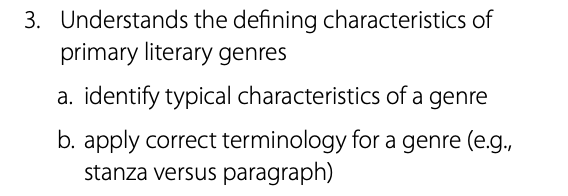
The following table defines typical characteristics and terminology of major
literary genres.

Figurative Language
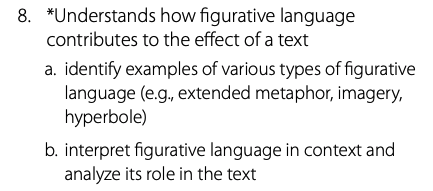
Figurative language is used in writing and speaking so that the message being conveyed is more effective, impactful, and/or persuasive.
This topic could be tested in the constructed-response question for this category, so it is important to be able to recognize and interpret figurative language.
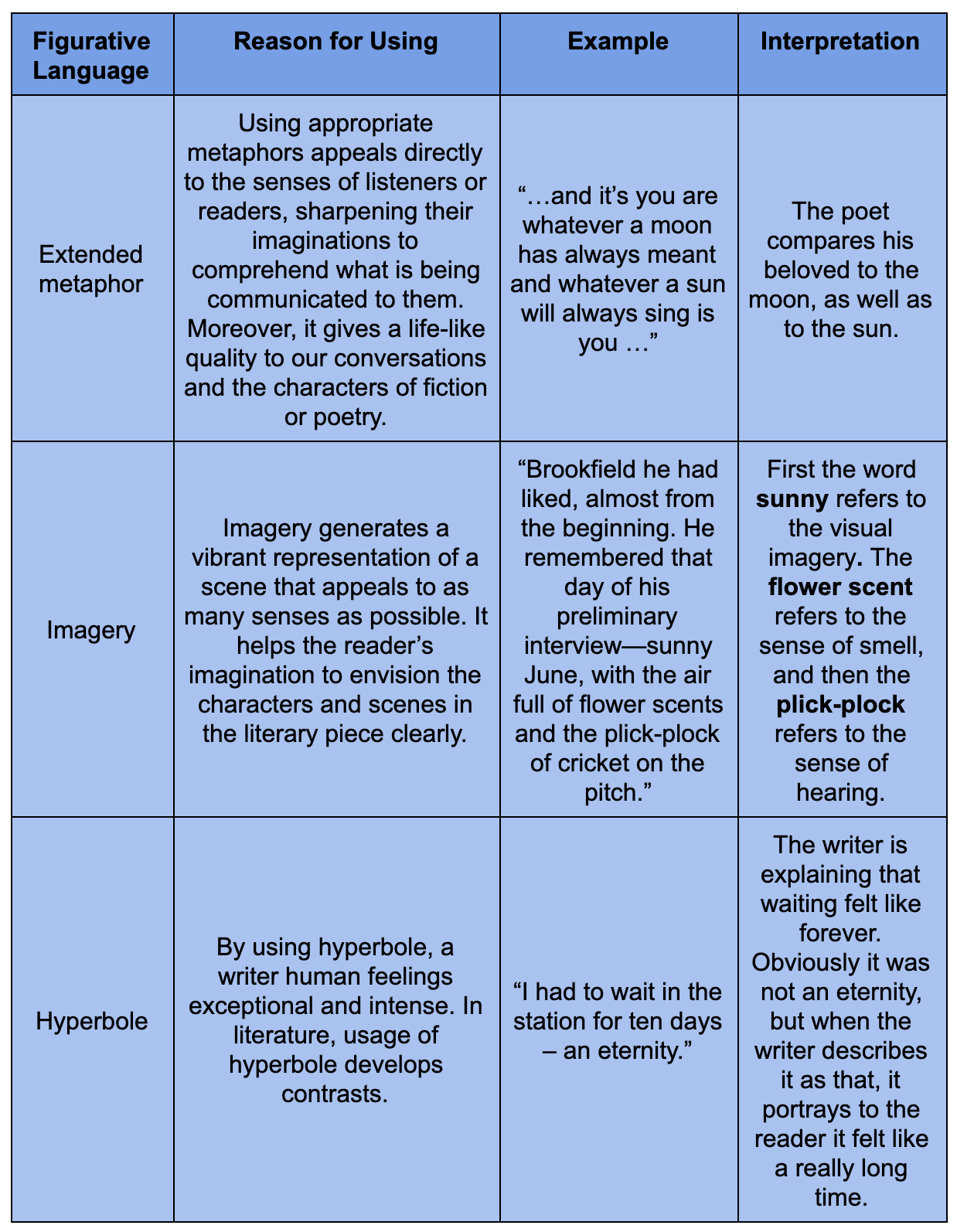
Common Strategies for Reading Instruction
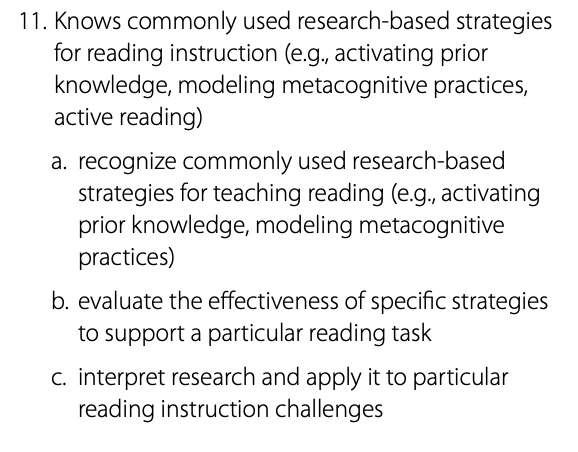
- Activating prior knowledge is important for students to build on what they already know and make connections.
- Modeling metacognitive practices helps students know what is expected of them.
- Active reading is reading for a purpose. Students need to be taught strategies to dive deeper into the text.examples: marking texts, summarizing, rereading
- Turn and talk is used for peer to peer learning. Students are able to feel more comfortable with their peers and converse with them on the text to clarify misconceptions.
- Graphic organizers are used to organize a reader’s thoughts so they are able to better understand the text.
- examples: t-chart, bubble map, venn diagram
Informational Texts and Rhetoric
Check out these two specific concepts about nonliterary texts.
Organizational Pattern of an Informational Text
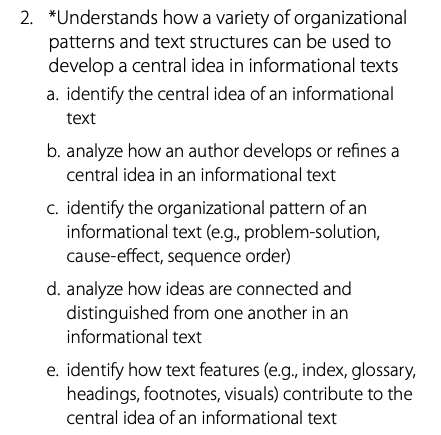
Informational text will be organized in one of five ways:
- Problem-solution
- Cause-effect
- Sequence order
- Description
- Compare/contrast
This topic could be measured in the constructed response-question for this category, so it is important to be able to identify organizational patterns.
Problem-Solution
Problem-solution is an organizational pattern where information in a passage is written as a problem and something was, could be, or should be done to fix the issue. This structure can be easily confused with cause and effect, but can be identified when you look specifically for a problem and solution, not just why or how something happened.
- Problem-solution signal words: answer, propose, solution, issue, problem, problematic, remedy, prevention, fix.
Cause-Effect
Cause and effect is an organizational pattern where Information in a passage is structured to describe why something happened, or the effects of something. Generally, this structure is used in expository and persuasive text.
- Cause-effect signal words: as a result, because, caused, since, due to, resulted, effect.
Sequence Order
Sequence order is an organizational pattern where a passage is organized by the order in which it occurs. Usually this organizational pattern is used when giving instructions or directions, but it can also be used to explain various processes in nature or politics.
- Sequence order signal words: first, next, before, then, lastly
Description
The descriptive organizational pattern is used to give a detailed description of something so the reader gets a mental picture while reading.
- Description signal words: describe, for instance, such as, characteristic
Compare and Contrast
Compare and contrast is a pattern of organization where the similarities and differences of two or more things is described. For a text to be considered a compare and contrast piece it must discuss similarities AND differences. If just similarities, or just differences are described, it is not truly compare and contrast.
Compare and contrast signal words: like, both, unlike, similar, neither, different
Rhetorical Strategies
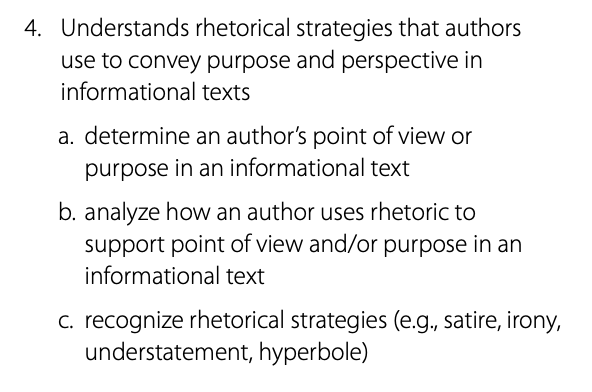
Rhetorical strategies are tools that help the author play on words to create an effect to their writing.
- Satire is the use of humor, exaggeration, or criticism to try to change the reader’s stance on an issue. An author sometimes uses it to influence the reader’s political or social opinion.
- Irony is when the unexpected happens in a situation that is expected. Example:Raining on your wedding day. Being offered a free dessert after you’ve already paid for yours.
- Understatement is making something seem less important. The author might use an understatement to be polite or sensitive to the reader.
- Hyperbole is an exaggeration or overstatement. The author might use hyperbole to be more dramatic or add a level of humor to the text.
Methods of Appeal or Persuasion

Authors use various methods when trying to persuade or appeal to a reader. Three of the most common are using expert opinions, generalizations, and testimonials.
- Expert opinions are typically used to try to sell a product or experience. An author will use the word of an expert in a given field to try to appeal to readers. For example, if an author is trying to persuade parents to use a new sunscreen for their child, the author could quote a pediatric dermatologist who claims their sunscreen is medically superior to other products.
- Generalizations are sweeping statements about a whole group, but based only on one or two members of that group. If the reader believes the generalization it can be effective in persuading the reader, but if the author is not believed, a generalization could actually discredit the author. For example, if a newspaper wrote an article on two teenagers stealing from a convenience store, and called for all teenagers to have stricter curfews in place because most teenagers steal.
- Testimonials are used to typically sell a product or experience, usually in ads, and are a person’s written or spoken statement about a product. For example, if a celebrity gives a testimonial about a new skin cream and an author uses that to try and persuade readers to also use the skin cream, it could be more persuasive than not having the testimonial.
Praxis 5039 Category II: Language Usage and Vocabulary
This content category has 33 selected-response questions. These questions account for 19% of the entire exam.
The Language Use and Vocabulary content category can be broken down into
5 competencies:
- Conventions of Standard English
- Word Meaning
- Reference Materials
- Dialect and Diction
- Language Acquisition and Vocabulary Development
Let’s look at each of these competencies and discuss a specific concept from
each one.
Conventions of Standard English

Sentence Structures
- Simple sentences are complete thoughts that contain a subject and a verb. They are referred to as an independent clause.
- Compound sentences have two independent clauses connected by a conjunction or semicolon.
- Example: I like running and he likes running.
- Complex sentences begin with an independent clause and have a conjunction that connects a dependent clause. The connected dependent clause does not express a complete thought.
- Example: I missed my bus because I was late.
- Complex-compound sentences have two independent clauses and one or more dependent clauses connected by conjunctions.
- Example: Paul did not run in the race because he was sick so he was disappointed.
Word Meaning

Affixes
Affixes are 1 or more letters added to a base word to change its meaning. If you understand the meaning of the affix it can help you to determine what the derivative means.
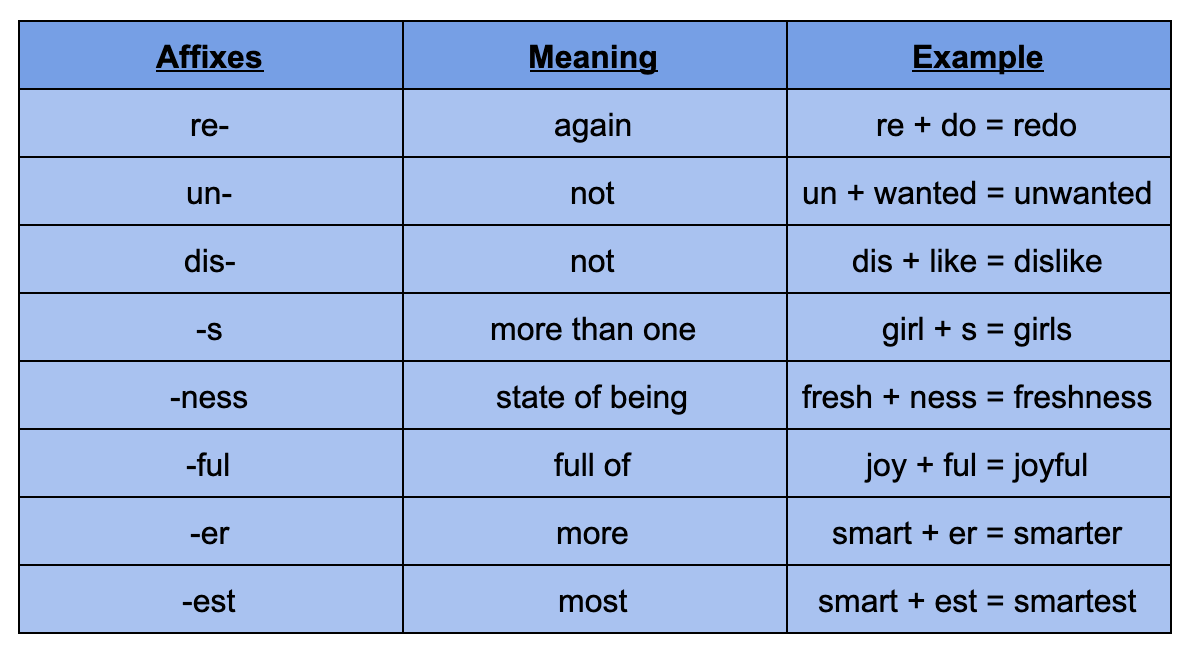
Reference Materials
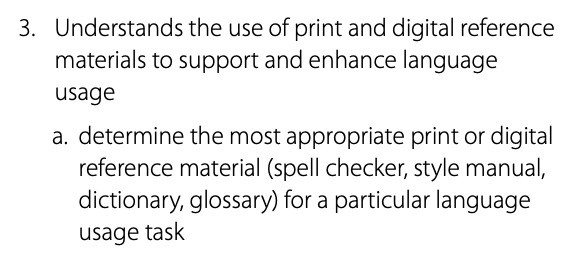
Digital Reference Materials
Digital reference materials are powerful tools to use in the classroom. It is important to educate students how to use print and digital reference materials and how to choose the appropriate reference material for a given task.
Common digital reference materials in the classroom include:
- Spell check- Spell check is a great tool for all students to use, and would be great for students to use in the editing phase of their writing. There are many apps that can be added to a computer and spell check is embedded into most word processing programs, such as MS Word.
- Style manual- The MLA Style Center is a great digital reference for students who are learning to write in the MLA style. This would be a great tool for middle and high school students who are tasked with writing a research paper; it is also a great tool to prepare students for writing in college.
- Dictionary- Merriam-Webster offers an online dictionary with material for all grade levels. This would be a great tool to use when introducing vocabulary and giving students the opportunity to look up words, how they’re used in sentences, parts of speech for the word, etc.
- Glossary- Glossaries are great points of reference for students who are looking up information. Digital glossaries can be found online by topic and could be a great tool for students who are gathering research or wanting to learn more about a topic.
Dialect and Diction
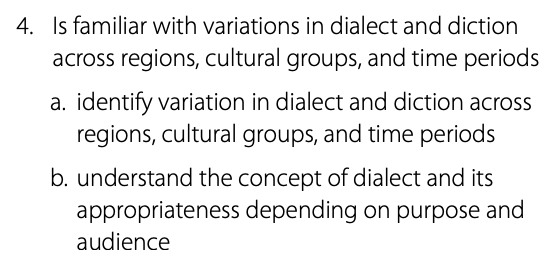
This competency tests your knowledge of dialect and diction.
Dialect
Dialect is specific to each region, cultural group, or time period. It is the way language is expressed within a group of people that they understand. In the United States you can recognize where a person is from based on how they greet someone.
Example: If you live in the south you might greet someone with a “Howdy,” while in the north a simple “hello” or “hi” would be used.
Dialect can even be specific to a genre of literature that is specific to the time period. For example, Shakespearean dialect usually needs to be translated into modern English to understand the text.
Language Acquisition and Vocabulary Development
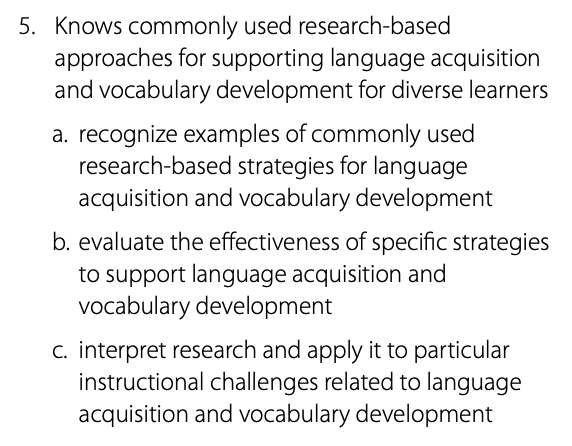
Language Development
When children develop their first language it is usually automatic and effortless, but second language acquisition takes more time. Students progress through 5 phases of language development.
- Pre-production has minimal comprehension and is more reliant on nodding and pointing than verbal responses.
- Early production has more comprehension and one or two-word responses.
- Speech emergence has good comprehension but makes grammatical errors and frequently does not understand the slang of peers or jokes.
- Intermediate fluency has great comprehension and makes fewer grammatical errors.
- Advanced fluency is close to the equivalency level of a native speaker.
Students should progress through each stage and receive specific support to help them succeed in school. When teachers provide appropriate support for students they create a safe environment for students to learn and grow.
III: Writing, Speaking, and Listening
This content category has 49 selected-response questions and 1 constructed-response question. These questions account for 41% of the entire exam.
The Writing, Speaking, and Listening content category can be broken down into
10 competencies:
- Modes of Writing
- Task, Purpose, and Audience
- Clear and Coherent Writing
- Research Practices
- Speech and Presentation Delivery
- Teaching Students to Use Digital Media
- Teaching Components of Writing
- Assessing Reading, Writing, Speaking, and Listening
- Oral Communication
- Incorporating Student Diversity
Let’s look at each of these competencies and discuss a specific concept from
each one.
Modes of Writing
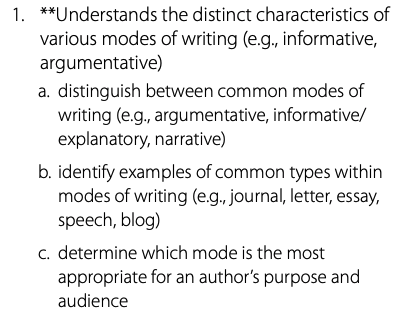
Common Modes of Writing
It is important to be able to distinguish between common modes of writing (argumentative, informative/explanatory, and narrative) and to be able to recognize modes of writing in different text.
This competency may be measured in the constructed-response question for this category.
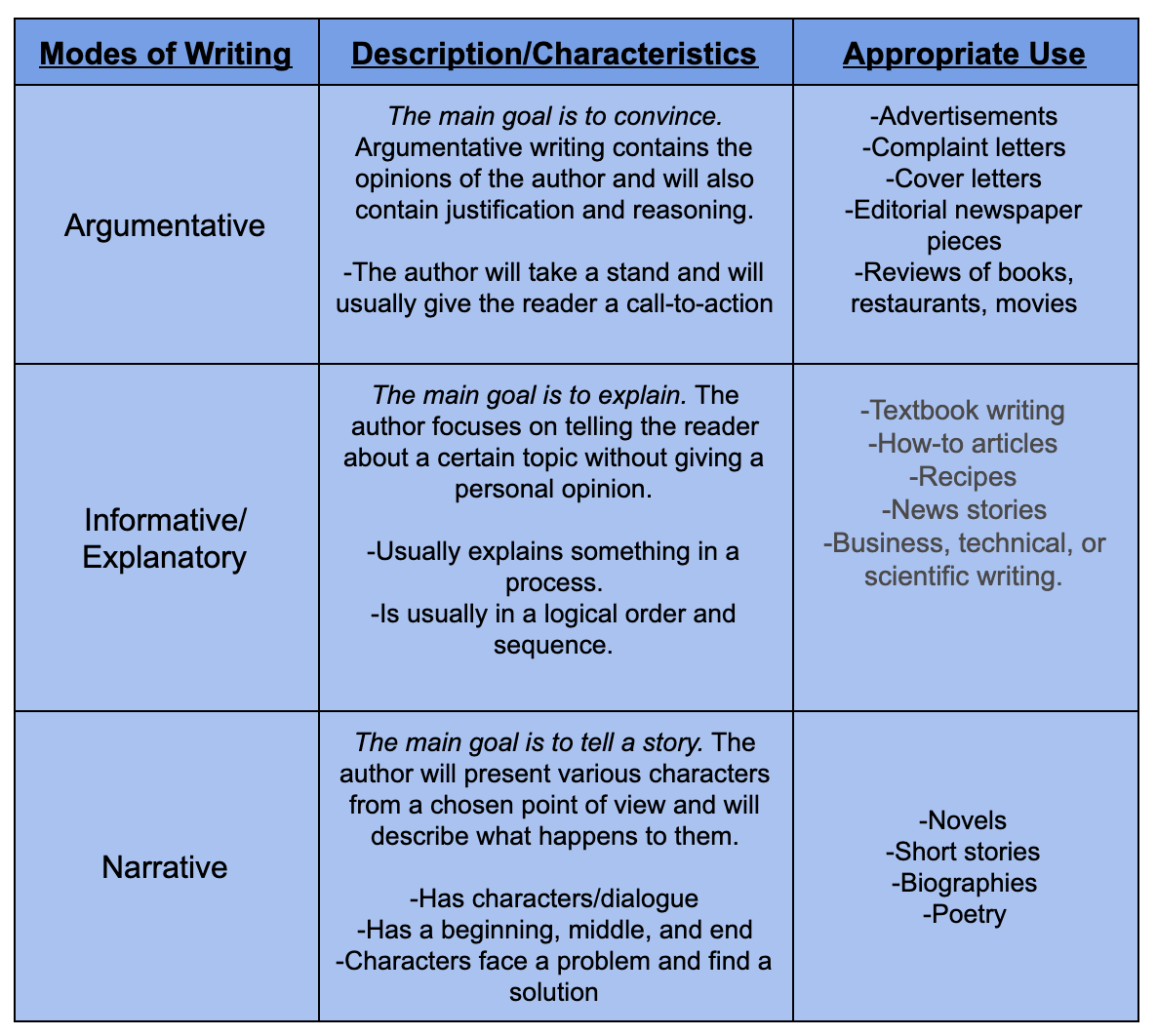
Task, Purpose, and Audience
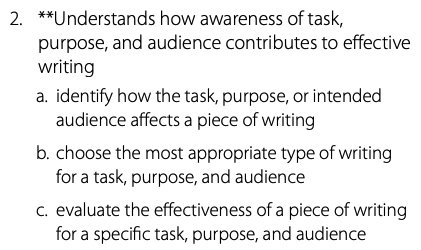
Purpose
Awareness of task, purpose, and knowing the audience all contributes to effective writing. It is important to understand the author’s purpose because this competency may be measured in the constructed-response question for this category.
An author’s purpose is the reason or intent in writing. An author might write to entertain the reader, inform the reader, or persuade the reader.
Generally, an author will write to:
- Retell events or a story (narrative/entertain).
- Explain what something looks like, feels like, sounds like (descriptive).
- Persuade a reader to believe an idea or take a specific course of action (persuasive).
- Inform or instruct the reader (expository).
At times the author’s purpose is clear, but other times it is more difficult to
interpret. However, an author’s purpose will always be reflected in the way he/she writes about a topic. For example, if the writer is trying to entertain the reader he will use jokes, satire, or anecdotal stories. If the purpose is less clear, clues can always be found in the title of the text, prefaces, and potentially in background information about the author.
Clear and Coherent Writing
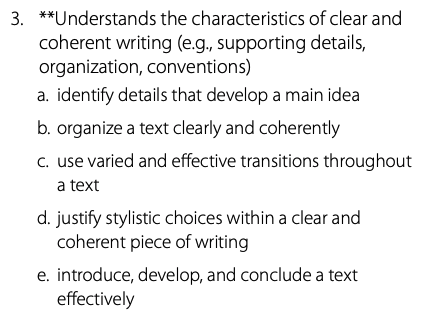
Effective Transitions
Transitions are necessary for clear and coherent writing because they help establish logical connections between sentences and paragraphs in writing. Transitions help readers understand what to do with the text and can be single words, phrases, or complete sentences.
This competency may be measured in the constructed-response question for this category.

Research Practices
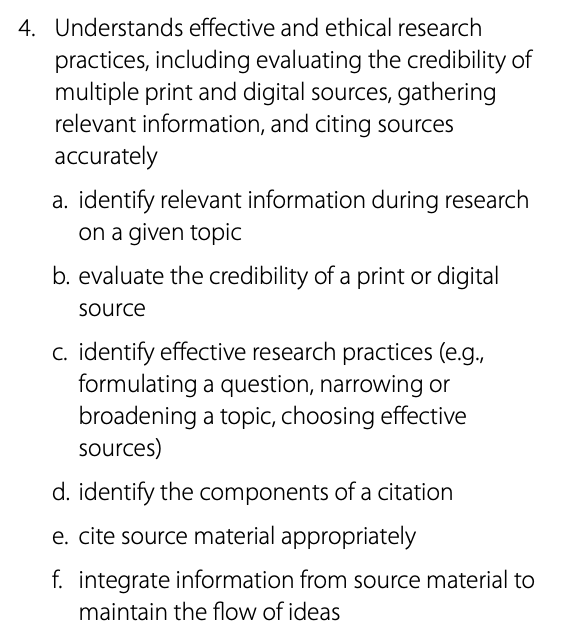
Components of a Citation
The components of a citation include the who, what, when, and where of a source.
- The Who= the author of the source.
- The What= the title of the source.
- The When= the date of when the source was published.
- The Where= where the source was published or where to find it online.
Example of MLA citation:
Rowling, J. K.
Harry Potter and the Sorcerer’s Stone
. New York: Scholastic, 1999. Print.
Speech and Presentation Delivery

Characteristics of Effective Delivery of a Presentation
- Eye contact involves being able to read the room and look for reactions, and also being able to keep your eyes up and look the audience in the eyes.
- Visual aids could include powerpoints, videos, charts or graphs. Being able to create a visual helps the audience to see and relate to the topic you’re explaining.
- Tone creates the mood of your presentation. Being able to use your voice effectively to create an appropriate tone for your presentation includes being able to control your volume, clarity, pauses, and use emphasis when needed.
Teaching Students to Use Digital Media
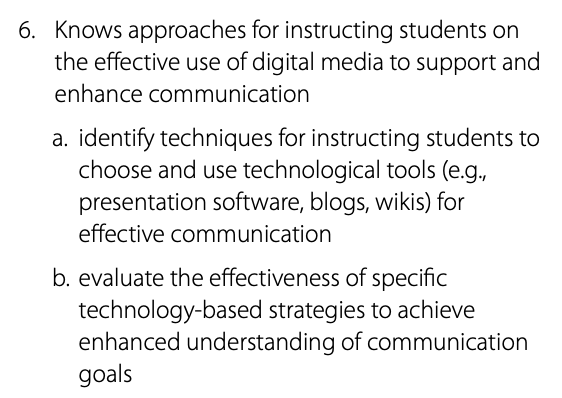
Technological Tools for Effective Communication
- Presentation software like Prezi or Microsoft Powerpoint can be used in the classroom to teach students how to present a topic.
- Software can be used in the classroom to communicate between students and parents.Examples: email, Remind 101
- Blogs can be used for students to write and respond to their peers’ writing. They can also gain information from blogs to relate to a topic.
- Wikis allow for a group of people to collaborate and create content on a specific topic. Wikis are helpful when teaching students how to collaborate during group projects.
Teaching Components of Writing
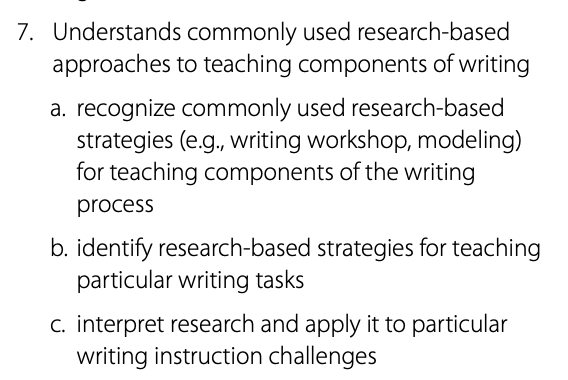
Writing Workshop
Writing workshop is designed to have students become better writers by writing. It consists of four main components.
- Mini-lesson is only about 5-10 minutes and in a whole group setting. Teachers bring students together to be direct and focus on specific writing skills. For example, it may include expectations of the writing process, the qualities of good writing, and editing skills.
- Writing usually lasts about 35-45 minutes and is where students are working independently on their writing and going through the writing process.
- Conferring happens during the independent writing time. Teachers monitor writing around the room and use this time to pull individual students or small groups who are struggling on an area of the writing process to work with them.
- Share Time is when students choose a part or a whole piece of their writing to share with the entire class. It is a time when students learn how to appropriately respond to other’s writing.
Assessing Reading, Writing, Speaking, and Listening
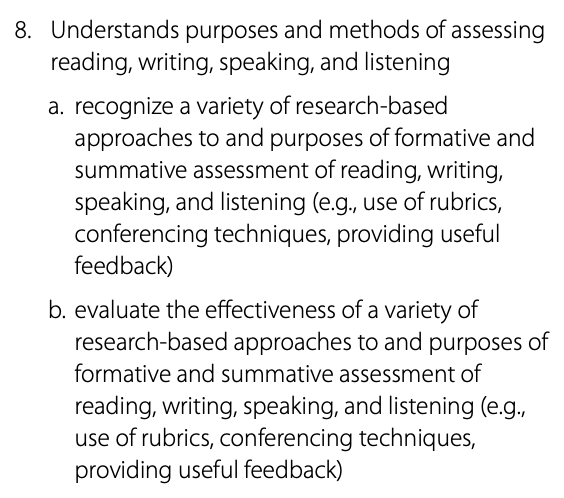
Using Rubrics to Assess Writing
Rubrics can be used as a tool to assess writing in the form of research papers, projects, presentations, and portfolios. Rubrics should be provided to and discussed with all students at the beginning of an assignment so that students know exactly what the expectations and learning goals of the assignment are. Students should know exactly what the teacher is looking for and grading, so that they have all the information necessary to demonstrate mastery. Once the assignment is complete, the teacher will use the rubric to grade each assignment, and will offer feedback on the rubric. The rubric is then returned to the student. A post conference to evaluate the results is also beneficial.
Rubrics have many advantages.
Rubrics help teachers:
- Give timely and consistent feedback to students.
- Save time when grading writing.
- Clarify expectations and assignment components for teachers and students.
- Plan instruction based on the results from the rubric score.
Rubrics help students:
- Understand and meet all expectations of an assignment.
- Improve work through detailed feedback from the teacher.
- Become more aware of the entire learning process.
Here is an example of a simple rubric to assess a personal narrative:

Oral Communication

Active Listening
Active listening is a very important skill for students because it is fully concentrating on what is being said rather than just hearing information. When students are listening actively they are listening with all senses and giving full attention to the speaker. This is a learned skill for students and can be encouraged by the teacher.
A 9th-grade English teacher is beginning a whole group lesson, and needs every student’s attention. To ensure that all of her students are actively listening she should look for :
The teacher can encourage active listening by encouraging/praising students who are actively listening, modeling what an active listener looks/sounds like when students are presenting, and role playing so that students understand the expectations.
Incorporating Student Diversity
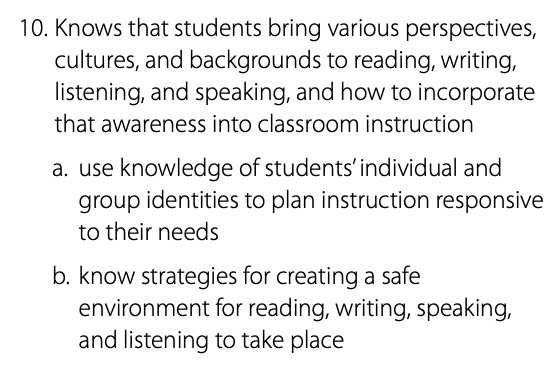
Creating a Safe Environment
Students can not learn if they do not feel safe. One of the most important things a teacher can do is establish a safe classroom, not only physically, but mentally and emotionally. Students must be able to write and say their thoughts as well as listen to others while feeling safe and comfortable. Strategies to help create a safe learning environment are:
- Keeping your classroom clean and organized.
- Celebrate student work in many different ways.
- Allow students to express themselves and encourage others.
- Establish a list of expectations/classroom commitments that details non-negotiables (no bullying, name calling, etc.).
- Always stay calm and in control.
- Turn mistakes into learning opportunities.
- Model kindness and explain to students how you handle “failure” or disappointment.
- Connect with students by moving around the classroom and interacting daily.
- Provide students with as many choices as possible.
- Provide students with statement stems that they can use to respectfully agree or disagree. For example, post somewhere in the room statements such as: “I agree with you because _____________.” or “I disagree with you because _____________.”
And that’s some basic info about the Praxis 5039 exam.
